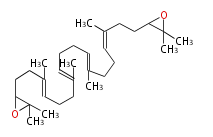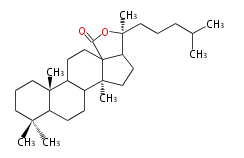Category:TP3
m (→{{Bilingual|Oxidosqualene Cyclase in Eukaryotes|真核生物のオキシドスクアレン環化酵素}}) |
m (→{{Bilingual|バクテリア・シダ類のスクアレン環化酵素|Squalene Cyclase in Bacteria and Ferns}}) |
||
| (7 intermediate revisions by one user not shown) | |||
| Line 1: | Line 1: | ||
==Triterpene (C30)== | ==Triterpene (C30)== | ||
| − | =={{Bilingual|Ring configuration | + | =={{Bilingual|環の構造|Ring configuration}}== |
| − | ==={{Bilingual | + | ==={{Bilingual|ステロイド|Steroid}}=== |
{{Twocolumn| | {{Twocolumn| | ||
The basic structure is 4 carbon rings, cyclopenta[a]phenanthrene, gonane, or sterane. | The basic structure is 4 carbon rings, cyclopenta[a]phenanthrene, gonane, or sterane. | ||
| Line 48: | Line 48: | ||
</center> | </center> | ||
| − | ==={{Bilingual | + | ==={{Bilingual|トリテルペン|Triterpenes}}=== |
{{Twocolumn| | {{Twocolumn| | ||
| Line 56: | Line 56: | ||
}} | }} | ||
| − | =={{Bilingual | + | =={{Bilingual|生合成|Biosynthesis}}== |
| − | ==={{Bilingual | + | ==={{Bilingual|概要|Overview}}=== |
{{Twocolumn| | {{Twocolumn| | ||
The starting point is squalene, which is formed by joining two FPPs tail-to-tail. | The starting point is squalene, which is formed by joining two FPPs tail-to-tail. | ||
| Line 82: | Line 82: | ||
* バクテリアでは、スクアレンが環化して17α-ダンマラン型カチオンとなり、最終的にホペン等のトリテルペンになります。 | * バクテリアでは、スクアレンが環化して17α-ダンマラン型カチオンとなり、最終的にホペン等のトリテルペンになります。 | ||
* 真核生物では、2,3-オキシドスクアレンが環化してプロトステロール型カチオンを作り、プロトンとメチル基の転移 (Wagner-Meerweinシフト) を経て1,2-ラノステロール (動物や真菌類)、シクロアルテノール (植物)や、パルケオール(ナマコ) になります。 | * 真核生物では、2,3-オキシドスクアレンが環化してプロトステロール型カチオンを作り、プロトンとメチル基の転移 (Wagner-Meerweinシフト) を経て1,2-ラノステロール (動物や真菌類)、シクロアルテノール (植物)や、パルケオール(ナマコ) になります。 | ||
| − | * 植物ではラノステロールからも一部の植物ステロールが合成されます。シロイヌナズナの '''At3g45130''' はラノステロール合成遺伝子であり、オーソログが菊類の [[Species:Taraxacum|''Taraxacum officinale'']] や [[Species:Panax|''Panax ginseng]]、 真正バラ類の [[Species:Luffa|''Luffa cylindrica]] にあることから、真正双子葉類に幅広く見られると考えられます。パーケオールも幅広い植物に見られます。 | + | * 植物ではラノステロールからも一部の植物ステロールが合成されます。シロイヌナズナの '''At3g45130''' はラノステロール合成遺伝子であり、オーソログが菊類の [[Species:Taraxacum|''Taraxacum officinale'']] や [[Species:Panax|''Panax ginseng'']]、 真正バラ類の [[Species:Luffa|''Luffa cylindrica'']] にあることから、真正双子葉類に幅広く見られると考えられます。パーケオールも幅広い植物に見られます。 |
* 更に植物の場合、17β-ダンマラン型のカチオンから様々なトリテルペンが生成されます。 | * 更に植物の場合、17β-ダンマラン型のカチオンから様々なトリテルペンが生成されます。 | ||
}} | }} | ||
| Line 90: | Line 90: | ||
<br/> | <br/> | ||
| − | ==={{Bilingual|Oxidosqualene Cyclase in Eukaryotes | + | ==={{Bilingual|真核生物のオキシドスクアレン環化酵素|Oxidosqualene Cyclase in Eukaryotes}}=== |
{{Twocolumn| | {{Twocolumn| | ||
Any path of reactions from the root (2,3-oxidosqualene) to any triterpene backbone with a colored background is catalyzed by a single enzyme called ''oxidosqualene cyclase'' (OSC) or ''terpene synthase h'' (tpsh).<ref>Terpene synthases a-f are responsible for mono-, sesquie- and diterpenes. Tps g is the squalene cyclase.</ref> | Any path of reactions from the root (2,3-oxidosqualene) to any triterpene backbone with a colored background is catalyzed by a single enzyme called ''oxidosqualene cyclase'' (OSC) or ''terpene synthase h'' (tpsh).<ref>Terpene synthases a-f are responsible for mono-, sesquie- and diterpenes. Tps g is the squalene cyclase.</ref> | ||
| Line 100: | Line 100: | ||
{| | {| | ||
|- | |- | ||
| − | ! {{Bilingual|Backbone Color Code | + | ! {{Bilingual|骨格色分け:|Backbone Color Code:}} |
! style="background-color:#fdd"| Animals, fungi, and yeast | ! style="background-color:#fdd"| Animals, fungi, and yeast | ||
! style="background-color:#dfd"| Plants only | ! style="background-color:#dfd"| Plants only | ||
! | ! | ||
|- | |- | ||
| − | ! {{Bilingual|Six-membered rings | + | ! {{Bilingual|6員環表記:|Six-membered rings:}} |
! colspan="2" | chair (C), or boat (B) | ! colspan="2" | chair (C), or boat (B) | ||
|} | |} | ||
| Line 137: | Line 137: | ||
|} | |} | ||
|- | |- | ||
| − | | 17β-protosteryl cation <small>(C-B-C)</small><ref>The C-17 chain of rotosteryl cation is β-configuration, not α.<br/> ''Ref.'' Corey EJ, Virgil SC (1991) An experimental demonstration of the stereochemistry of enzymic cyclization of 2,3-oxidosqualene to the protosterol system, forerunner of lanosterol and cholesterol. [http://pubs.acs.org/doi/abs/10.1021/ja00010a073 ''J Am Chem Soc'' 113:4025-6]</ref> <br/>[[Image:Protosteryl cation.png]] | + | | 17β-protosteryl cation <small>(C-B-C)</small><ref>The C-17 chain of rotosteryl cation is β-configuration, not α.<br/> ''Ref.'' Corey EJ, Virgil SC (1991) An experimental demonstration of the stereochemistry of enzymic cyclization of 2,3-oxidosqualene to the protosterol system, forerunner of lanosterol and cholesterol. [http://pubs.acs.org/doi/abs/10.1021/ja00010a073 ''J Am Chem Soc'' 113:4025-6]</ref> <br/>[[Image:Protosteryl cation.png|150px]] |
| 1,2-shift<br/>[[Image:Arrow00r.png]] | | 1,2-shift<br/>[[Image:Arrow00r.png]] | ||
| − | | colspan="2"|lanosteryl cation <small>(C- | + | | colspan="2" align="left"|lanosteryl cation <small>(C-B-C)</small><br/>[[Image:Lanosteryl cation.png|150px]] |
| − | | 17β-dammarenyl cation <small>(C-C-C)</small><ref>The C-17 chain of dammarenyl cation is β-configuration.<br/> ''Ref.'' Xiong Q, Rocco F, Wilson WK, Xu R, Ceruti M, Matsuda SPT (2005) Structure and reactivity of the dammarenyl cation: configuration transmission in triterpene synthesis. ''J Org. Chem. 70:5362-75</ref> <br/>[[Image:Dammarenyl cation.png]] | + | | 17β-dammarenyl cation <small>(C-C-C)</small><ref>The C-17 chain of dammarenyl cation is β-configuration.<br/> ''Ref.'' Xiong Q, Rocco F, Wilson WK, Xu R, Ceruti M, Matsuda SPT (2005) Structure and reactivity of the dammarenyl cation: configuration transmission in triterpene synthesis. ''J Org. Chem. 70:5362-75</ref> <br/>[[Image:Dammarenyl cation.png|150px]] |
|- | |- | ||
|colspan="2"| | |colspan="2"| | ||
| Line 173: | Line 173: | ||
|} | |} | ||
|- valign="top" | |- valign="top" | ||
| − | |colspan="2"| cation with the chain at C18 or C17 position<br/>[[Image:CBCC cation.png]]or [[Image:CBCC cation2.png]] | + | |colspan="2"| cation with the chain at C18 or C17 position<br/>[[Image:CBCC cation.png|150px]]or [[Image:CBCC cation2.png|100px]] |
| | | | ||
{| | {| | ||
|style="background-color:#fdd"| all steroids<br/>lanostane<br/>cycloartane<br/>cucurbitane<br/>ergostane etc. | |style="background-color:#fdd"| all steroids<br/>lanostane<br/>cycloartane<br/>cucurbitane<br/>ergostane etc. | ||
|} | |} | ||
| − | | | + | |style="vertical-align:bottom"| |
| − | {| | + | {| style="margin-left:auto;margin-right:0;" |
| − | + | ||
| − | + | ||
|style="background-color:#dfd"| baccharane<br/>shionane | |style="background-color:#dfd"| baccharane<br/>shionane | ||
| [[Image:Arrow00l35.png]] | | [[Image:Arrow00l35.png]] | ||
|} | |} | ||
| − | | baccarenyl cation <small>(C-C-C-C)</small><br/>[[Image:Baccarenyl cation.png]] | + | | baccarenyl cation <small>(C-C-C-C)</small><br/>[[Image:Baccarenyl cation.png|150px]] |
|- | |- | ||
| | | | ||
| Line 199: | Line 197: | ||
|} | |} | ||
| | | | ||
| − | | | + | | |
| − | + | {| style="margin-left:auto;margin-right:0;" | |
| E-ring cyclization<br/>(from 17α/β) | | E-ring cyclization<br/>(from 17α/β) | ||
| [[Image:Arrow00dl.png]] | | [[Image:Arrow00dl.png]] | ||
| Line 210: | Line 208: | ||
|} | |} | ||
|- valign="top" | |- valign="top" | ||
| − | | arborinyl cation <small>(C-B-C-C)</small><br/>[[Image:Arborinyl cation.png]] | + | | arborinyl cation <small>(C-B-C-C)</small><br/>[[Image:Arborinyl cation.png|150px]] |
| − | | colspan="2" align="left"| unnamed cation <small>(C-B-C-C)</small><br/>[[Image:Hanco cation.png]] | + | | colspan="2" align="left"| unnamed cation <small>(C-B-C-C)</small><br/>[[Image:Hanco cation.png|150px]] |
| − | | 21α-hopyl cation <small>(C-C-C-C)</small><br/>21β-moretyl cation <small>(C-C-C-C)</small><ref>The 21''R'' stereocenter is usually lost in hydride shift.</ref><br/>[[Image:Hopyl cation.png]] | + | | 21α-hopyl cation <small>(C-C-C-C)</small><br/>21β-moretyl cation <small>(C-C-C-C)</small><ref>The 21''R'' stereocenter is usually lost in hydride shift.</ref><br/>[[Image:Hopyl cation.png|150px]] |
| − | | H18α-lupyl cation <small>(C-C-C-C)</small><br/>H18β-lupyl cation <small>(C-C-C-B)</small><br/>[[Image:Lupyl cation.png]] | + | | H18α-lupyl cation <small>(C-C-C-C)</small><br/>H18β-lupyl cation <small>(C-C-C-B)</small><br/>[[Image:Lupyl cation.png|150px]] |
|- | |- | ||
|align="left"| | |align="left"| | ||
| Line 250: | Line 248: | ||
</center> | </center> | ||
| − | {| class="wikitable collapsible | + | {| class="wikitable collapsible" style="width:100%" |
! References | ! References | ||
|- | |- | ||
| Line 262: | Line 260: | ||
|} | |} | ||
| − | ==={{Bilingual|Squalene Cyclase in Bacteria and Ferns | + | ==={{Bilingual|バクテリア・シダ類のスクアレン環化酵素|Squalene Cyclase in Bacteria and Ferns}}=== |
{{Twocolumn| | {{Twocolumn| | ||
| Line 273: | Line 271: | ||
{| style="text-align:center" | {| style="text-align:center" | ||
| − | | squalene<br/>[[Image:squalene.png]] | + | | squalene<br/>[[Image:squalene.png|150px]] |
| [[Image:Arrow00r.png]]<br/>squalene-hopene cyclase<ref>SH cyclase is the most investigated enzyme among squalene cyclases. <br/>''Ref.'' Kannenberg EL, Poralla K (1999) Hopanoid biosyntehsis and function in bacteria. ''Naturwissenschaften'' 86:168-76.</ref> | | [[Image:Arrow00r.png]]<br/>squalene-hopene cyclase<ref>SH cyclase is the most investigated enzyme among squalene cyclases. <br/>''Ref.'' Kannenberg EL, Poralla K (1999) Hopanoid biosyntehsis and function in bacteria. ''Naturwissenschaften'' 86:168-76.</ref> | ||
| 17α-deoxydammarenyl cation<ref>The C-17 chain of deoxydammarenyl cation is α-configuration, not β as in eukaryotes.<br/> | | 17α-deoxydammarenyl cation<ref>The C-17 chain of deoxydammarenyl cation is α-configuration, not β as in eukaryotes.<br/> | ||
| − | ''Ref.'' Wendt KU, Schulz GE, Corey EJ, Liu DR (2000) Enzyme mechanisms for polycyclic triterpene formation. [http://www3.interscience.wiley.com/journal/72515653/abstract?CRETRY=1&SRETRY=0 ''Angew Chem, Int Ed'' 39:2812-33]</ref> <br/>[[Image:Deoxydammarenyl cation.png]] | + | ''Ref.'' Wendt KU, Schulz GE, Corey EJ, Liu DR (2000) Enzyme mechanisms for polycyclic triterpene formation. [http://www3.interscience.wiley.com/journal/72515653/abstract?CRETRY=1&SRETRY=0 ''Angew Chem, Int Ed'' 39:2812-33]</ref> <br/>[[Image:Deoxydammarenyl cation.png|150px]] |
|- | |- | ||
| | | | ||
| Line 287: | Line 285: | ||
|} | |} | ||
|- | |- | ||
| − | |style="background-color:#ddf"| hopene<br/>[[Image:Hopene.png]] | + | |style="background-color:#ddf"| hopene<br/>[[Image:Hopene.png|150px]] |
| [[Image:Arrow00l.png]] | | [[Image:Arrow00l.png]] | ||
| − | | hopyl cation <br/>[[Image:Hopyl cation.png]] | + | | hopyl cation (c-c-c-c)<br/>[[Image:Hopyl cation.png|150px]] |
|} | |} | ||
{{Twocolumn| | {{Twocolumn| | ||
| − | Hopanoids are widespread: they are found in bacteria, ferns, and geological sediments. | + | Hopanoids are widespread: they are found in bacteria, ferns, and geological sediments. They are not found, however, in archaea or animals. |
| + | |||
| | | | ||
| − | + | ホパノイドはバクテリアだけでなく、シダ類や地下堆積物からも見つかっています。しかしアーキアや動物からは見つかっていません。 | |
}} | }} | ||
| Line 308: | Line 307: | ||
<references/> | <references/> | ||
| − | ==={{Bilingual|Bis-oxidosqualene Cyclase | + | ==={{Bilingual|ビスオキシドスクアレン環化酵素|Bis-oxidosqualene Cyclase}}=== |
{{Twocolumn| | {{Twocolumn| | ||
Squalene is oxidized by squalene oxidase to become 2,3-oxidosqualene. | Squalene is oxidized by squalene oxidase to become 2,3-oxidosqualene. | ||
| Line 331: | Line 330: | ||
<references/> | <references/> | ||
| − | =={{Bilingual|Design of Tri-terpene ID numbers | + | =={{Bilingual|ID番号の設計|Design of Tri-terpene ID numbers}}== |
<center> | <center> | ||
12-DIGIT | 12-DIGIT | ||
Latest revision as of 11:55, 8 December 2012
Contents |
[edit] Triterpene (C30)
[edit] Ring configuration
[edit] Steroid
The basic structure is 4 carbon rings, cyclopenta[a]phenanthrene, gonane, or sterane. The rings B/C are always trans in all natural steroids. If the rings C/D are trans, it is called gonane. If its stereochemistry is unspecified, it is called sterane. Most steroids take gonane form, but in cardenolides and bufanolides, the rings C/D are cis.
 |

|
| Cyclopenta[a]phenanthrene | Gonane |
The majority of steroids have methyl groups sticking out from the bridgehead positions C-10 and C-13. When these methyl groups (or hydrogens) stand above the plane, they are called β-configuration. Those below the plane are called α-configuration. If the configuration at any site is unknown, it is indicated as ξ (Greek Xi). By default, hydrogen atoms or substituents at the positions C-8, 9, 10, 13, and 14 are assumed to be 8β, 9α, 10β, 13β, and 14α configurations. C-5 is a special position, because there are as many 5α steroids as 5β are.
 |
 |

|
| cholestane backbone | 5α-configuration | 5β-configuration |
[edit] Triterpenes
In almost all pentacyclic triterpenes in angiosperms, the methyl group at the DE-ring fusion is β-configuration. Some triterpenes in ferns, mosses, gymnosperms have α-methyl group at the DE-ring fusion.
[edit] Biosynthesis
[edit] Overview
The starting point is squalene, which is formed by joining two FPPs tail-to-tail. Bacterial cyclases use squalene directly[1], but those of the other species use 2,3-oxidosqualene for cyclization.

|

|
| squalene | 2,3-oxidosqualene |
- In bacteria, squalene is cyclized via the 17α-deoxydammarenyl cation to hopene and other triterpenes.
- In eukaryotes, 2,3-oxidosqualene is cyclized via the protosteryl cation to lanosterol (animals and fungi), cycloartenol (plants) or parkeol (sea cucumbers) by a series of 1,2-hydride and methyl shifts (Wagner-Meerwein shifts).
- In plants, a trace amount of phytosterols comes from lanosterol [2] At3g45130 is lanosterol synthase in Arabidopsis and its orthologs exist in asterids Taraxacum officinale and Panax ginseng and eurosid Luffa cylindrica. Lanosterol synthase exists broadly among eudicots [3]. Parkeol is also widespread in plants.
- In plants, various triterpenes arise from the 17β-dammarenyl cation.
- References
- ↑ Bacterial squalene cyclases can accept oxidosqualene as their substrates, but oxidosqualene usually does not exist in bacteria
- ↑ Ohyama K, Suzuki M, Kikuchi J, Saito K, Muranaka T (2009) Dual biosynthetic pathways to phytosterol via cycloartenol and lanosterol in Arabidopsis Proc Natl Acad Sci USA 106(3):725-730
- ↑ Kolesnikova MD, Xiong Q, Lodeiro S, Hua L, Matsuda SPT (2006) Lanosterol biosynthesis in plants Arch Biochem Biophys 447:87-95
[edit] Oxidosqualene Cyclase in Eukaryotes
Any path of reactions from the root (2,3-oxidosqualene) to any triterpene backbone with a colored background is catalyzed by a single enzyme called oxidosqualene cyclase (OSC) or terpene synthase h (tpsh).[1]
| Backbone Color Code: | Animals, fungi, and yeast | Plants only | |
|---|---|---|---|
| Six-membered rings: | chair (C), or boat (B) | ||
| 2,3-oxidosqualene | |||||||||||||||||

| |||||||||||||||||
|
| ||||||||||||||||
17β-protosteryl cation (C-B-C)[5] 
|
1,2-shift |
lanosteryl cation (C-B-C)
|
17β-dammarenyl cation (C-C-C)[6] 
| ||||||||||||||
|
|
| |||||||||||||||
cation with the chain at C18 or C17 position or or 
|
|
|
baccarenyl cation (C-C-C-C)
| ||||||||||||||
|
|
|
| ||||||||||||||
arborinyl cation (C-B-C-C)
|
unnamed cation (C-B-C-C)
|
21α-hopyl cation (C-C-C-C) 21β-moretyl cation (C-C-C-C)[10] 
|
H18α-lupyl cation (C-C-C-C) H18β-lupyl cation (C-C-C-B) 
| ||||||||||||||
|
|
|
| ||||||||||||||
| arborinane (C-B-C-C) stictane (C-B-C-C-C)[11] |
hancokinane (C-B-C-C) | hopane (C-C-C-C) gammacerane (C-C-C-C-C) fernane (C-C-C-C) swertane (C-C-C-C-C) |
oleanane[12] (C-C-C-C-C) lupane (C-C-C-C) germanicane taraxastane (C-C-C-C-C) ursane (C-C-C-C-C/B) friedomadeirane (C-C-C-C)[13] | ||||||||||||||
| References |
|---|
|
| Reviews |
|
[edit] Squalene Cyclase in Bacteria and Ferns
Squalene cyclase (SC) or terpene synthase g (tpsg) are found in prokaryotes, ciliates, and lower plants (mosses and ferns) and can convert squalene, which is symmetric, as well as 2,3-oxidosqualene. Main products are hopanol and tetrahymanol, and only generate all-chair cations.
squalene
|
squalene-hopene cyclase[1] |
17α-deoxydammarenyl cation[2] 
| |||
| |||||
hopene
|
|
hopyl cation (c-c-c-c)
|
Hopanoids are widespread: they are found in bacteria, ferns, and geological sediments. They are not found, however, in archaea or animals.
Almost all mono-, di-, tri- and tetracyclic terpenes from squalene are found in ferns: Polypodium, Lemmaphyllum, and Pyrrosia. Notable exception is Z-Dammara-17(20),24-diene from moss Floribundaria[3]. Pentacyclic terpenes from squalene, on the other hand, are found also in angiosperms such as Achillea, Erysimum, Castanopsis and in Ascomycota.
- ↑ SH cyclase is the most investigated enzyme among squalene cyclases.
Ref. Kannenberg EL, Poralla K (1999) Hopanoid biosyntehsis and function in bacteria. Naturwissenschaften 86:168-76. - ↑ The C-17 chain of deoxydammarenyl cation is α-configuration, not β as in eukaryotes.
Ref. Wendt KU, Schulz GE, Corey EJ, Liu DR (2000) Enzyme mechanisms for polycyclic triterpene formation. Angew Chem, Int Ed 39:2812-33 - ↑ Toyota M, Masuda K, Asakawa Y (1998) Triterpenoid constituents of the moss Floribundaria aurea subsp. nipponica. Phytochemistry 48:297–299
[edit] Bis-oxidosqualene Cyclase
Squalene is oxidized by squalene oxidase to become 2,3-oxidosqualene. Further epoxidation of this symmetric molecule produces 2,3-(S)-22,23-(S)-bis-oxidosqualene, which is converted to 24,25-epoxylanostan-3-ol or 24,25-epoxycycloartan-3-ol. Epoxylanosterol is known to negatively regulate sterol biosynthesis[1].

|

|
| 2,3-oxidosqualene | 2,3-22,23-bis-oxidosqualene |
- ↑ Gardner RG, Shan H, Matsuda SPT, Hampton RY (2001) A positive oxysterol-derived signal for 3-hydroxy-3-methylglutaryl CoA reductase degradation in yeast. J Biol Chem 276:8681–869
[edit] Design of Tri-terpene ID numbers
12-DIGIT
| T | P | 3 | x | y | y | r | h | g | n | c | c |
- x ... species information
| Symbol at x | Kingdom | Phyla | Examples |
|---|---|---|---|
| I | Animalia | Arthropoda (Insects, crabs) | ecdysteroids |
| V | Chordate (Vertebrates) | sex steroids, corticosteroids, anabolic steroids | |
| O | Others | marine steroids | |
| P | Plantae | Phytosterols | lanosterols, cholesterols, brassinolides |
| S | Saponins | saponins | |
| F | Fungi | ergosterols | ergosterols |
| B | Bacteria | bacterial sterols | hopanoids |
- y ... backbone structure (母核構造)
- r ... number of major rings (環構造数)
Click above categories to see details.
- h ... hydroxylation pattern (水酸基数)
Click above categories to see details.
- g ... glycosylation pattern(糖修飾パターン)
Click above categories to see details.
- n ... number of sugars (修飾糖数)
Click above categories to see details.
- c ... serial number (通し番号)
This category currently contains no pages or media.

























